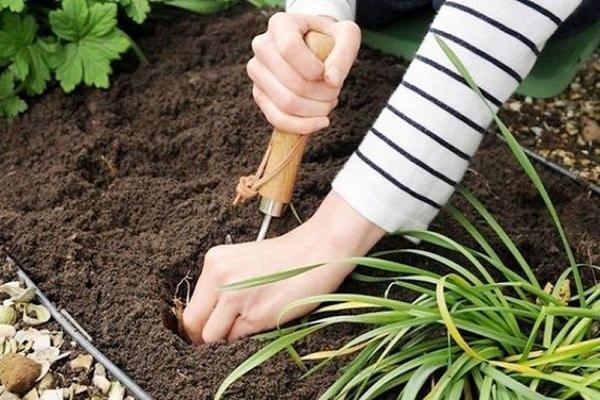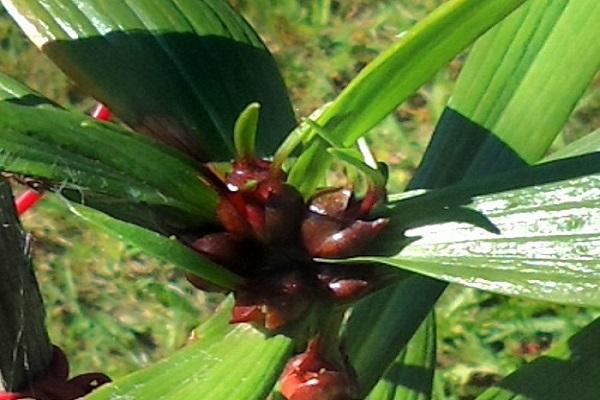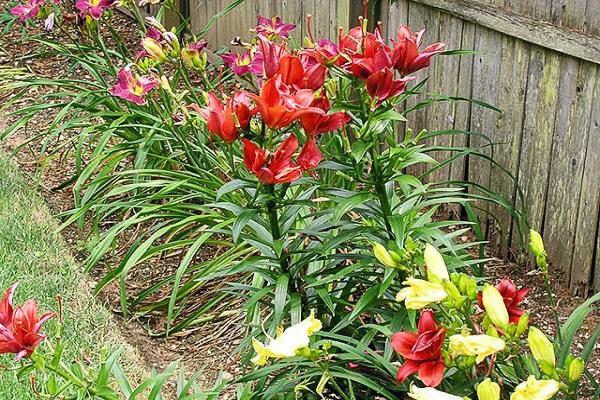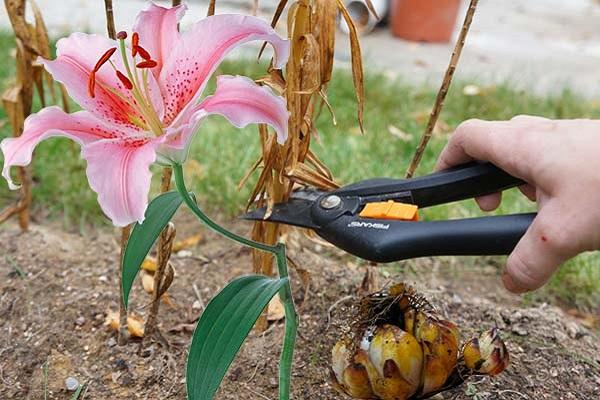The peculiarity of lilies is their growth. Every year the plantation becomes denser, and there is not enough space for the flowers. Therefore, lilies will have to be replanted at least not every year, but some varieties need to be replaced every 3-4 years, others less often. This is how the growth of stems and the size of the flower are regulated.
- Why is a transplant needed and what will happen if you don’t do it?
- When is the best time to replant lilies?
- When to replant lilies in the fall
- Spring and summer transplantation of lilies
- Features of various regions of Russia
- How to transplant lilies correctly
- New place in the garden
- Preparing planting holes and flower beds
- Reproduction methods
- The immediate transplant process
- Caring for lilies after transplantation
Why is a transplant needed and what will happen if you don’t do it?
Garden lilies actively develop and bloom during the first 3 years after planting. Then the flowers begin to shrink. Thickened plantations do not allow young shoots to develop. The plant begins to age and wither.
A garden lily should be replanted if it:
- stopped growing;
- becomes covered with withered leaves and withers;
- gets a fungal or bacterial infection;
- has grown greatly.
For each type of plant, the frequency of transplants varies. For American hybrids, it is enough to change their place in the garden once a decade. Tubular and Asian varieties require annual replanting. Their bulbs reproduce faster.
When is the best time to replant lilies?
In which month it is better to replant a garden crop depends on where it is cultivated. Where it is warm, you can start moving part of the daylily to another place in October. Previously, the procedure was carried out in gardens located in central Russia. The best adaptation of ornamental plants occurs when the buds have fallen 20-30 days ago.
When to replant lilies in the fall
The choice of the best period for transplanting an ornamental crop is related to the timing of its flowering. The autumn procedure is favorable for most species. The readiness of the bulbs is determined by the state of dormancy and their collection of nutrients before wintering.
In September, the time comes to replant those plants that bloomed in July-August. Late-blooming lilies should be dug up and moved to a new location in October. In areas with an early onset of winter, it is better to postpone the procedure to spring. Otherwise, the beginning drop in temperature will destroy the fragile lily bulbs.
If you choose the wrong time and the soil in the garden begins to cool, then you need to take care of covering material for the flower plantation.
Spring and summer transplantation of lilies
Bulbs prepared for transplantation are left until spring if planting time is missed. All that remains is to preserve them correctly. The accumulation of nutrients in the bulbs is considered important. To prevent the planting material from drying out and remaining moist until spring, place the bulbs in a plastic bag, placing them on the bottom shelf of the refrigerator or lowering them into the cellar. For better preservation, lilies need air, so holes are made in the bag.
In the spring, after the soil has warmed up to 8-10 degrees Celsius, the plants are planted in a permanent place in the garden.
It is better to replant types of lilies such as Snow White after flowering in the summer. During the dormant period, which occurs in July-August, the bulbs are prepared for planting. They are dug up, treated with “Fundazol” and placed in a hole with nutrient soil. In September, new rosettes will begin to form on the roots. But for this type of lily, it is enough to change the place in the garden once every 5 years.
The Asian class of flowers is not afraid of replanting with flower buds. They tolerate the procedure easily and take root quickly. In order for the plant to have enough strength to adapt to new conditions, the inflorescences are cut off. Next summer the lily will delight you with large buds.
Features of various regions of Russia
The peculiarity of lilies is that they can be cultivated in regions with any climate. But the timing of plant transplantation will change. In the fall, you need to have time to plant a month before the onset of cold weather. In Siberia, this period falls in September; a little later you can do gardening in a temperate climate.
In the spring, in the southern regions you can begin planting procedures as early as April, in the Moscow region - in early May, in gardens beyond the Urals - after May 15.The main thing here is to have time so that the plant does not start expelling the arrow with the bud.
How to transplant lilies correctly
Before you start replanting an ornamental crop, you should prepare for the procedure. Determine where the lilies will be best. They tolerate the proximity of other flowers and conifers well.
New place in the garden
Lilies bloom brightly where there is a lot of sun and little shade. You should not choose a place where the shadow of large trees falls on the site. But direct rays of the sun are also dangerous for garden plants. Flowers do not tolerate strong winds or drafts. Most often they choose a place where there is a fence.
The soil in the new place for flowers should be nutritious and loose. The depth of groundwater is preferably 2 -2.5 meters to the surface. It cannot be planted in lowlands, otherwise the swampy area will lead to rotting of the bulbs.
Soil acidity for daylilies is needed at a neutral level.
Preparing planting holes and flower beds
It’s worth starting to prepare the holes for lily bulbs 2 weeks in advance. Dig the soil to a depth of 3-5 centimeters. If the soil is poor, humus is added, and superphosphate and potassium fertilizers are added. It is better to spread the mixture before digging the area.
For places with high acidity, dolomite flour or slaked lime must be added. It is forbidden to fertilize the flowerbed with fresh manure. This will cause fungal infections in the plants. Roots can be burned by organic matter when heat is released from them.
Reproduction methods
Transplantation is often combined with propagation of flower plants. You can use the babies formed on the bulbs for this purpose. They are separated by planting in separate beds.
In some types of crops, aerial bulbs and bulblets are formed in the leaves. They also make excellent propagation material in the spring.
A productive way to increase the number of lilies can be the outer white scales. After digging the bulb, it is cleared of soil. Remove 6-8 scales and plant them in a separate bed. In autumn, you can place the material in sphagnum moss, wet peat, placed in plastic bags. Store seed material in a warm place. When it produces bulbs, they are replanted. The plant will begin to bloom only after 2 years.
Cuttings are harvested after the lily has bloomed. Although they use shoots with buds. They are covered with soil and waited for rooting. As soon as the bulbs begin to form, give them the opportunity to get stronger. In a month they are ready for planting.
The immediate transplant process
After preliminary preparation of the site and choice of transplantation method, faded lilies are dug up. Garden forks are used for the procedure. They cannot damage the planting material. The stem is easily separated from the roots. Having cleared the sockets from the ground, they are washed and inspected for damage and rot. It is better to trim the roots, leaving 20-30 centimeters of their length.
It is necessary to disinfect planting material in solutions of the drug “Maxim” or potassium permanganate with a concentration of 1%.
Determine the depth of immersion of the bulbs at 5-8 centimeters, depending on the size. Tall varieties are buried 10 centimeters. The gap between the holes is 15-30 centimeters. Determine the interval from what type of lily. Larger ones need more space, shorter ones need less.
Place a layer of drainage or coarse sand on the bottom of the hole.Place an onion in the center of the hole and cover it with a layer of nutrient substrate. It is necessary that the earth fits tightly between the roots. After transferring from one place to another, water the plants and mulch the plantation with peat, sawdust or humus.
Caring for lilies after transplantation
After replanting in the fall, conditions for a successful winter are created for the plants. In addition to saturating the soil with moisture, plants are fed with organic and mineral fertilizers. What you need most before winter is potassium and phosphorus. Therefore, they water it with an ash solution.
In areas with cold winters, you need to add a layer of fallen leaves, placing boards on top. Can be covered with layers of non-woven material. You should not close it too early, otherwise the bulbs will begin to rot. Shelter daylily planting should be done when the temperature drops to 0 degrees.
In the spring, after removing the covering material, nitrogenous fertilizers are applied. They stimulate the growth of green mass. Phosphorus and potassium are needed before flowering. Water the daylily so that the soil is moistened evenly.
Transplanted lilies do not always bloom in the first year. With good care, their flowering will be sure and bright next summer.



















